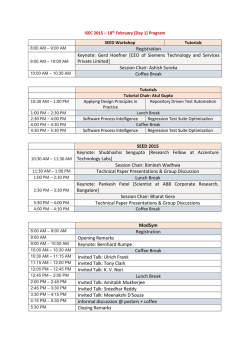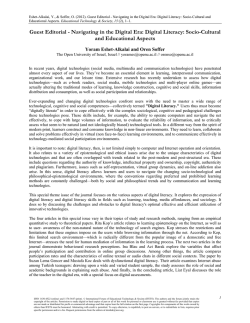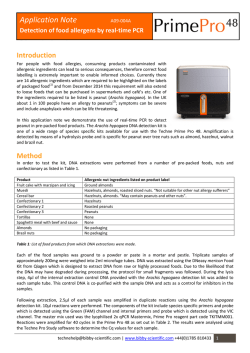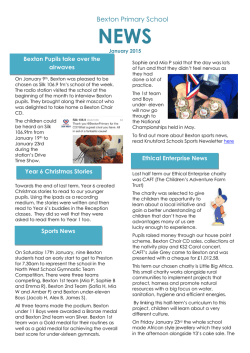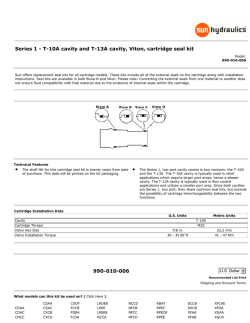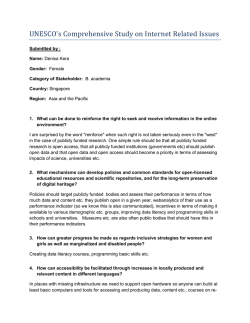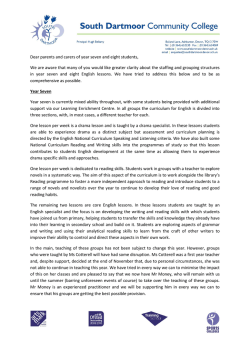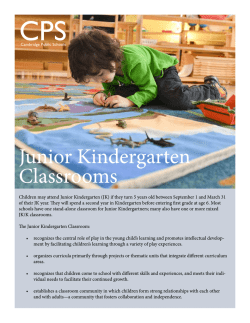
National Leader in Evaluation Results
LANL Foundation Inquiry Science Education Program is a National Leader in Evaluation Results With New Mexico consistently ranking last or nearly last in most areas of education, there is now reason to celebrate success in student learning and achievement. After four years of implementation of the Northern New Mexico Inquiry Science Education Consortium (ISEC), an independent evaluation shows that students in the program have made “statistically significant” improvements in grades 4, 5 and 6 in every subject included in the New Mexico Standards-Based Assessment (SBA), evaluated by ISEC. When compared to students of similar demographics not participating in the program, ISEC students scored an average of 4 to 7 points higher not only in science but also in reading, writing and math. The LANL Foundation believes that every child should have access, equity and excellence in education. The Foundation invests in learning and human potential and implements evidence-based programs that improve student achievement. Without hard work and dedication of teachers and active support of schools and district leaders, ISEC would remain theory-based without practice or results. Congratulations and gratitude go out to those educators who committed to and trusted in a shared vision for student success! What is Inquiry Science? Inquiry science is a learning process and teaching tool that encompasses authentic science investigations with comprehensive classroom instruction. Moving away from traditional science teaching methods using textbooks, worksheets and demonstrations, inquiry science uses children’s natural curiosity to inspire exploration and stimulate a sense of wonder and excitement. Grade Subject ISEC Year 3 ISEC Year 4 4 Math – + 4 Reading N.S. + 4 Science* N.S. + 5 Math N.S. + 5 Reading N.S. + 5 Writing* N.S. + 6 Math N.S. + 6 Reading + + 7 Science* N.S. N.S. ISEC Evaluation Results Using NMSBA Data *Science and writing are only evaluated in years indicated N.S. = non-significant difference “Kids are accumulating knowledge. Data shows that ISEC is making a significant improvement in schools that extends beyond science across all subjects reflecting systemic, cultural change.” –Eric Rolfhus, Lead Research Scientist on ISEC Evaluation, Edvance Research, Inc. Inquiry science teaches students how to think—not just what to think—through experimentation, research, reasoning, process and problem solving, combined with communication, relating to others, listening and caring, all of which strengthen intellect, social development and critical thinking. The process builds upon current science knowledge, encourages conceptualization of a question and discovery of possible explanations while accommodating different learning styles using speech, writing, data collection and drawing. Teacher professional development with Rocks & Minerals Inquiry science experiment with Magnetism & Electricity Writing in science notebooks “I see two magical things about this initiative. First, learning, engagement and rigor are all wonderfully visible—for students and teachers alike. Second, all of our voices emerge as scientists in our own right.” –Gwen Warniment, ISEC Director of Professional Development & Evaluation ISEC Science Kits by Grade Grade Physical Science Earth Science K Balls & Ramps Weather Balance & Motion Solids & Liquids Pebbles, Sand & Silt Organisms Soils Plant Growth & Development 1 2 3 Sound Magnetism & Electricity Mixtures & Solutions Levers & Pulleys 4 5 6 Sun, Moon & Stars Rocks & Minerals Life Science Seeds & Caterpillars Human Body Animal Studies Land & Water Microworlds Solar Energy Environments 2013–2014 Student Pre- & Post-Test Results Grade 3 3 3 4 4 4 5 5 5 6 6 6 Science Kit Sound Sun, Moon & Stars Human Body Magnetism & Electricity Rocks & Minerals Animal Studies Mixtures & Solutions Land & Water Microworlds Levers & Pulleys Solar Energy Environments Pre-test Post-test 33% 56% 32% 51% 32% 51% 21% 40% 30% 53% 54% 70% 17% 31% 47% 59% 44% 63% 23% 43% 27% 48% 33% 46% Gain 23% 19% 19% 19% 23% 16% 14% 12% 16% 20% 21% 13% The ISEC program model begins with teacher professional development and coaching, which lead to an increase in teacher knowledge and skills. This results in effective delivery of classroom science instruction and subsequently improves student achievement in science and positively influences literacy and math performance. Inquiry-based science kits and curriculum provided to teachers Teacher professional development and coaching Increased teacher content and pedagogical knowledge, skills and confidence in teaching science History of ISEC In 2010, the LANL Foundation established ISEC with four school districts (Española, Santa Fe, Mesa Vista and Peñasco) to maximize education funding and make a significant, measured impact on the lives of students in Northern New Mexico. The focus was on a range of rural, small town and large-sized districts, as well as program sustainability and potential scalability. The ISEC collaboration leveraged money and resources to bolster science education for elementary students, strengthened teacher practice in science—a traditionally underserved subject area—and built upon the positive impact inquiry science demonstrates with students in the “achievement gap” (English Language Learners, students who qualify for free/reduced lunch and Hispanic and Native American students). Program Design ISEC addresses challenges in science education in several ways with a research-based program model dependent upon curriculum, professional development and materials management. Earth, physical and life science curriculum is aligned with current NM content standards and Common Core State Standards. Lessons guide teachers not only what to teach but also how to teach science. Professional development (PD) is provided for teachers on each grade-specific kit during Summer Institutes. Condensed kit trainings are offered throughout the school year. Science Literacy Coaches hired by the districts provide ongoing classroom support. Guidance with effective teaching techniques addresses topics such as advanced content and pedagogy, visual literacy, formative assessment, notebooking and argumentation. Principals, assistant principals and superintendents are also trained for program understanding and teacher support. The Foundation’s Conference on Education brings in speakers who inspire educators and present trends and best practices. Science kits with all materials for hands-on experiments are delivered to and picked up from each school, then refurbished after each 12-week cycle. The Science Resource Center handles all ordering, scheduling and oversight of a warehouse and complex materials management system. Local resources and vendors are used whenever possible. Program results and effectiveness are measured using both student and teacher outcomes through an independent evaluator. Consistent funding and program management are provided by the LANL Foundation with minimal cost to schools. Effective delivery of classroom instruction Improved student achievement! Current Program ISEC currently exists in seven NM districts (Dulce, Española, Mesa Vista, Peñasco, Pojoaque, Santa Fe and Springer), serving 37 schools (elementary and some middle schools), 443 teachers and 11,224 students. Curriculum focuses on Earth, physical and life science. There are three kits per classroom at each grade level per year. The 2014–2015 operating budget is $1.9 million, and $10 million has been invested in the program over five years, with funding from the LANL Foundation and Los Alamos National Security, LLC (LANS), in addition to district support. The program has seven full-time staff, with additional part-time administrative support and assistance during the refurbishment process. “When we look at educational data, we realize how unfair it is to teachers. Most federal grants and education programs only last three years and do not fund for an appropriate evaluation. This is not long enough to see effective outcomes. Our results have come after year four. We don’t want to be the program du jour. If ISEC works we will continue.” –Susan Herrera, LANL Foundation CEO Program Evaluation To verify that ISEC is improving performance of high-need students in science, closing student achievement gaps, influencing literacy and math and improving teacher practice, LANL Foundation contracted the Research Educational Laboratory of Edvance Research, Inc. in San Antonio to design and implement a five-year evaluation at a cost of nearly $1 million. The evaluation consists of the following three components. Pre- and post-test data measures student knowledge and learning before and after each science module is taught in grades 3–6. These tests show that improvements exist in student content knowledge each year. Information is used to inform teacher PD. Data revealed that third grade typically shows the highest gains in test scores and the longer a teacher has been in ISEC, the more gains students make in that classroom. Observations of fourth grade teachers are conducted twice a year by the ISEC Director of Professional Development. Data collection and analysis examine program fidelity and results are used to inform and expand PD. A propensity match analysis is a statistical evaluation technique to observe data that compares individual ISEC students in contrast with nonparticipants of like demographics and characteristics such as race, gender, poverty index, English Language Learner status, special education status and rural school location. From the propensity match analysis of SBA test scores, Edvance found that: »“Statistically significant” positive results were seen in grades 4–6 in every evaluated subject area: math, reading, writing and science! »ISEC students average 4–7 points higher on SBA tests than students not in the program. »Improvements are typically better for students traditionally located in the “achievement gap.” Edvance reports that the What Works Clearinghouse (WWC), an initiative of the U.S. Department of Education’s Institute of Education Sciences, reviewed impacts of math PD on student achievement and found sparse positive evidence. Of the 910 studies reviewed, five met WWC standards, and only two showed positive effects on student math proficiency. This comparison further spotlights the impressive outcomes ISEC has displayed as the only evaluation in science meeting WWC standards with “statistically significant” positive results. Soils Students observe the water cycle and explain how rain occurs during a Land & Water kit experiment. Program Outcomes In addition to the formal evaluation results, ISEC has revealed several important findings: LANL Foundation’s Continued Commitment »Comprehensive science instruction and hands-on learning improve student achievement in science and influence literacy and math. »Success of this “relational” program is dependent upon the intensity of PD and ongoing teacher support. »Consistency of program leadership and active participation within schools are critical. The LANL Foundation is committed to playing an essential role in improving the quality of education in Northern New Mexico and will continue to build ISEC as an exceptional national model that: »Improves student achievement in science, »Cultural and systemic changes are possible in schools. literacy and math; »Leads with PD and teacher support; »Selects curriculum that stimulates students and aligns with education standards; »Maintains high levels of materials management and customer service; »Builds upon the culture of science created in schools; »Evaluates success and evolves as needed; and »Leverages funding and partnerships to support program sustainability and possible growth. »Inquiry science helps close the achievement gap in areas of poverty. »ISEC creates a common language of science in classrooms, schools and in the home. »Materials management is vital to program implementation. »General teaching practice is strengthened and teachers report that science instruction is now fun. »Student engagement, critical thinking, discussion-making skills and confidence are increased and learning science is fun. »$10 million was a wise investment in education. »This evidence-based program is successful and will continue! Future of ISEC ISEC will continue for an additional three years using lessons learned to evolve and streamline the program. Six school districts will be included (Dulce, Española, Mesa Vista, Peñasco, Pojoaque and Santa Fe) serving 37 elementary schools, 540 teachers and 12,200 students. Middle schools will not be included, since science is already taught daily. Curriculum will focus on Earth and physical science. Life science kits with live animals are difficult and costly to maintain. There will be two kits for grades K–6 per year, transitioning to align with current NM content standards as well as Next Generation Science Standards (NGSS). The 2015–2016 school year will include one kit currently in rotation, in addition to one new NGSS kit. School-wide commitments from principals are required to ensure accountability; district-wide participation is not mandatory. LANL Foundation will fund and manage the program for another three years. PD will continue with two trainers on staff at the LANL Foundation. Science Literacy Coaches are phased out. The independent evaluation will continue at a total three-year cost of approximately $121,500 including “latent growth model” analysis in order to understand student movement (frequent in areas of poverty) in addition to the propensity match analysis. Teacher observations will continue only to enhance PD. Pre- and posttests will be made available to teachers, but data will not be collected by ISEC (past data has already shown clear trends). Magnetism & Electricity Balls & Ramps F O R M O R E I N F O R M AT I O N : » Dorothy Sanchez, ISEC Program Director 505-753-8890 ext 120, [email protected] » Gwen Warniment, ISEC Director of Professional Development & Evaluation 505-753-8890 ext 117, [email protected] 1112 Plaza del Norte Española, NM 87532 www.lanlfoundation.org “We are very proud of the work teachers are doing in the classroom, especially with all of the changes and challenges they face. We’re here to listen and support them.” –Dorothy Sanchez, ISEC Program Director Human Body PD Science literacy
© Copyright 2025
